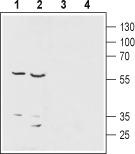ENT1 (SLC29A1) Rabbit Polyclonal Antibody
Other products for "SLC29A1"
Specifications
| Product Data | |
| Applications | IHC, WB |
| Recommended Dilution | WB: 1:200-1:2000; IHC: 1:100-1:3000 |
| Reactivities | Rat |
| Host | Rabbit |
| Clonality | Polyclonal |
| Immunogen | Peptide (C)EQETKLDLISKGEEPR, corresponding to amino acid residues 245-260 of human Equilibrative Nucleoside Transporter 1 . Intracellular, 3rd loop. |
| Formulation | Lyophilized. Concentration before lyophilization ~0.8mg/ml (lot dependent, please refer to CoA along with shipment for actual concentration). Buffer before lyophilization: Phosphate buffered saline (PBS), pH 7.4, 1% BSA, 0.05% NaN3. |
| Purification | Affinity purified on immobilized antigen. |
| Conjugation | Unconjugated |
| Storage | Store at -20°C as received. |
| Stability | Stable for 12 months from date of receipt. |
| Gene Name | solute carrier family 29 member 1 (Augustine blood group) |
| Database Link | |
| Background | Nucleosides play other important roles beyond their nucleic acid synthesis building block role. For example, they are involved in energy metabolism; they serve as ligands of purinergic receptors and act as influential signaling molecules. Being hydrophilic, nucleosides cannot simply diffuse across the plasma membrane in order to exert their various functions, but rather need to be physically transported via nucleoside transporters. Two different transporter families are responsible for transporting nucleosides across the plasma membrane: The Concentrative Nucleoside Transporter proteins (CNT, SLC28 family), which consist of three members, CNT1-3, and act as Na+-dependent symporters. The Equilibrative Nucleoside Transporter proteins ENT1-4 (ENT, SLC29 family), which mediate a Na+-independent facilitated diffusion. Therefore, ENTs act as bidirectional carriers, responsible for the influx and efflux of substrates. Structurally, ENT transporters have eleven transmembrane domains with an intracellular N-terminal and an extracellular C-terminal. The best characterized ENT transporters are ENT1 and ENT2, which although display a broader range of substrate selectivity, have lower affinities for nucleosides compared to concentrative transporters. They are ubiquitously expressed, for example ENT1 is expressed in erythrocytes, vascular endothelium, placenta, brain, heart, liver and colon. ENT2 displays more or less the same expression pattern but in addition, is strongly expressed in skeletal muscle. ENT3 is a lysosomal pH-dependent transporter capable of transporting adenine, and ENT4 also transports adenine at acidic pH. They are also broadly expressed with ENT3 displaying high expression in the placenta and ENT4 in the heart. As mentioned above, nucleosides have a variety of cellular/physiological functions suggesting that transporters responsible for their trafficking may also have functional attributes. Indeed, ENT1 plays a role in proliferation and therefore is responsible for the constitutive trafficking of nucleosides. There is no evidence that nucleoside transporters are directly involved in pathophysiologies, but they are clinically significant. For example, nucleoside transporters are responsible for the cellular uptake of a number of nucleoside-derived anticancer drugs. |
| Synonyms | ENT1 |
| Reference Data | |
| Protein Families | Transmembrane |
Documents
| Product Manuals |
| FAQs |
{0} Product Review(s)
0 Product Review(s)
Submit review
Be the first one to submit a review
Product Citations
*Delivery time may vary from web posted schedule. Occasional delays may occur due to unforeseen
complexities in the preparation of your product. International customers may expect an additional 1-2 weeks
in shipping.






























































































































































































































































 Germany
Germany
 Japan
Japan
 United Kingdom
United Kingdom
 China
China




